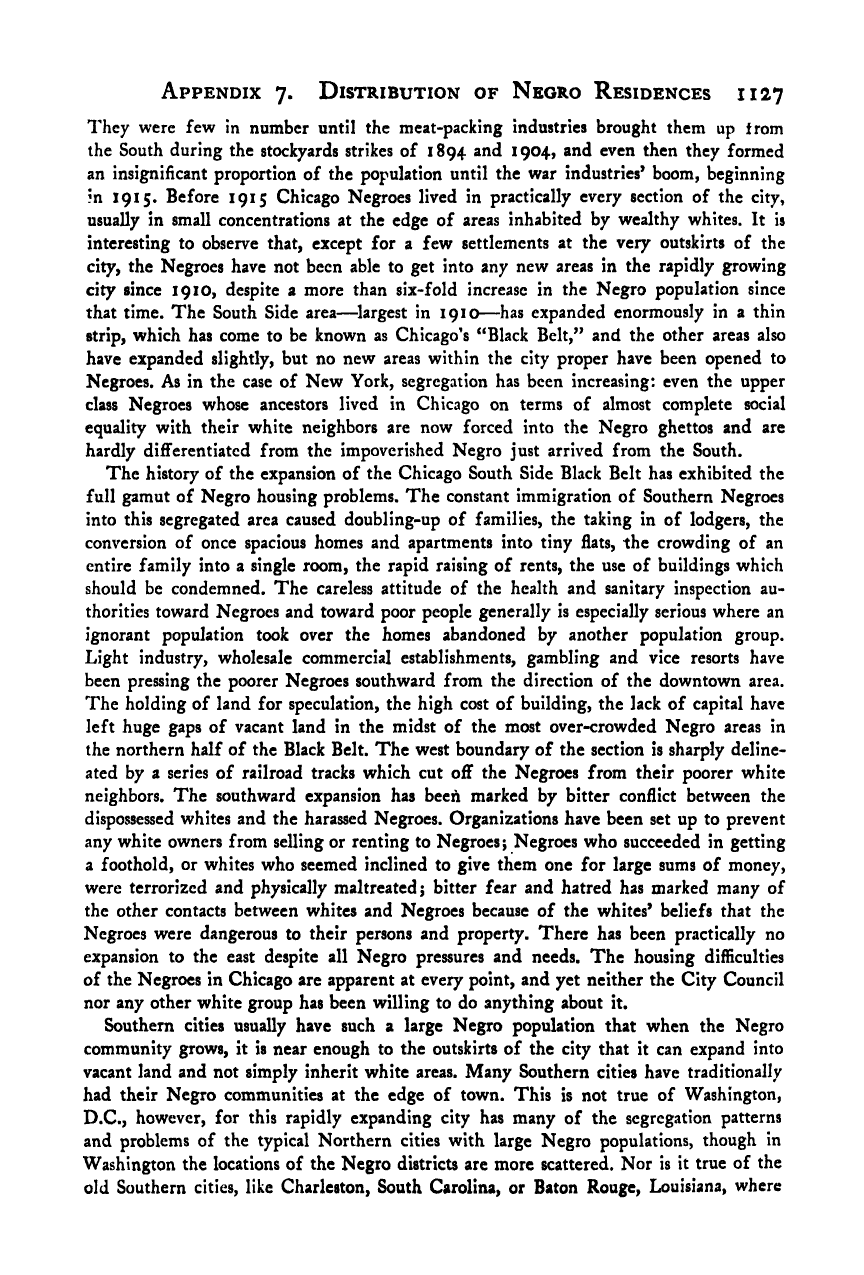Note: Gunnar Myrdal died in 1987, less than 70 years ago. Therefore, this work is protected by copyright, restricting your legal rights to reproduce it. However, you are welcome to view it on screen, as you do now. Read more about copyright.
Full resolution (TIFF) - On this page / på denna sida - Appendices - 7. Distribution of Negro Residences in Selected Cities

<< prev. page << föreg. sida << >> nästa sida >> next page >>
Below is the raw OCR text
from the above scanned image.
Do you see an error? Proofread the page now!
Här nedan syns maskintolkade texten från faksimilbilden ovan.
Ser du något fel? Korrekturläs sidan nu!
This page has never been proofread. / Denna sida har aldrig korrekturlästs.
Appendix 7. Distribution of Negro Residences 1127
They were few in number until the meat-packing industries brought them up from
the South during the stockyards strikes of 1894 and 1904, and even then they formed
an insignificant proportion of the population until the war industries’ boom, beginning
in 1915. Before 1915 Chicago Negroes lived in practically every section of the city,
usually in small concentrations at the edge of areas inhabited by wealthy whites. It is
interesting to observe that, except for a few settlements at the very outskirts of the
city, the Negroes have not been able to get into any new areas in the rapidly growing
city since 1910, despite a more than six-fold increase in the Negro population since
that time. The South Side area—^largest in 1910—has expanded enormously in a thin
strip, which has come to be known as Chicago’s “Black Belt,” and the other areas also
have expanded slightly, but no new areas within the city proper have been opened to
Negroes, As in the case of New York, segregation has been increasing: even the upper
class Negroes whose ancestors lived in Chicago on terms of almost complete social
equality with their white neighbors are now forced into the Negro ghettos and are
hardly differentiated from the impoverished Negro just arrived from the South.
The history of the expansion of the Chicago South Side Black Belt has exhibited the
full gamut of Negro housing problems. The constant immigration of Southern Negroes
into this segregated area caused doubling-up of families, the taking in of lodgers, the
conversion of once spacious homes and apartments into tiny flats, the crowding of an
entire family into a single room, the rapid raising of rents, the use of buildings which
should be condemned. The careless attitude of the health and sanitary inspection au-
thorities toward Negroes and toward poor people generally is especially serious where an
ignorant population took over the homes abandoned by another population group.
Light industry, wholesale commercial establishments, gambling and vice resorts have
been pressing the poorer Negroes southward from the direction of the downtown area.
The holding of land for speculation, the high cost of building, the lack of capital have
left huge gaps of vacant land in the midst of the most over-crowded Negro areas in
the northern half of the Black Belt. The west boundary of the section is sharply deline-
ated by a series of railroad tracks which cut off the Negroes from their poorer white
neighbors. The southward expansion has been marked by bitter conflict between the
dispossessed whites and the harassed Negroes. Organizations have been set up to prevent
any white owners from selling or renting to Negroes; Negroes who succeeded in getting
a foothold, or whites who seemed inclined to give them one for large sums of money,
were terrorized and physically maltreated; bitter fear and hatred has marked many of
the other contacts between whites and Negroes because of the whites’ beliefs that the
Negroes were dangerous to their persons and property. There has been practically no
expansion to the east despite all Negro pressures and needs. The housing difficulties
of the Negroes in Chicago are apparent at every point, and yet neither the City Council
nor any other white group has been willing to do anything about it.
Southern cities usually have such a large Negro population that when the Negro
community grows, it is near enough to the outskirts of the city that it can expand into
vacant land and not simply inherit white areas. Many Southern cities have traditionally
had their Negro communities at the edge of town. This is not true of Washington,
D.C., however, for this rapidly expanding city has many of the segregation patterns
and problems of the typical Northern cities with large Negro populations, though in
Washington the locations of the Negro districts are more scattered. Nor is it true of the
old Southern cities, like Charleston, South Carolina, or Baton Rouge, Louisiana, where
<< prev. page << föreg. sida << >> nästa sida >> next page >>